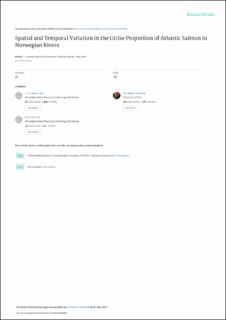Spatial and Temporal Variation in the Grilse Proportion of Atlantic Salmon in Norwegian Rivers
Journal article
Permanent lenke
https://hdl.handle.net/11250/2738778Utgivelsesdato
2004Metadata
Vis full innførselSamlinger
Sammendrag
Variation in the sea age at maturity of Atlantic salmon Salmo salar was studied in 158 Norwegian rivers over large spatial (58–71°N; 5–30°E) and temporal (1983–2000) scales. Age at sexual maturity was expressed as the proportion of grilse (fish with one sea winter) in the nominal salmon catch. No general temporal trend was found in the proportion of grilse in the catches. However, grilse proportion declined significantly in 10 rivers and increased significantly in 11 rivers out of the 55 rivers with data for all 18 years. There were no short-term cycles in grilse proportion within rivers. We found coherence and similarity in the temporal variation in grilse proportion for rivers draining into large fjord systems. Reasons for the temporal variation in grilse proportions must be sought at a river-specific or regional scale. River-specific factors (water discharge, river steepness, and presence of lakes) explained a large percentage of the spatial variation in grilse proportion. Grilse proportion increased with decreasing river size (measured as mean annual water discharge) and with increasing proportion of water discharge occurring during summer (i.e., the migration season). Grilse proportion was higher in rivers located nearer to the open ocean, probably indicating an effect of early feeding on growth and maturation. Even after accounting for environmental variation at the local scale, we found large regional differences in grilse proportion. Region captured this variation more efficiently than latitude, but grilse proportion was higher in the northern part of Norway than in the more southerly part. This variability may indicate large-scale differences in, for example, oceanic migration routes for fish originating from different regions.
